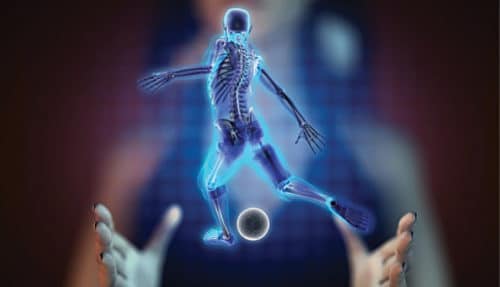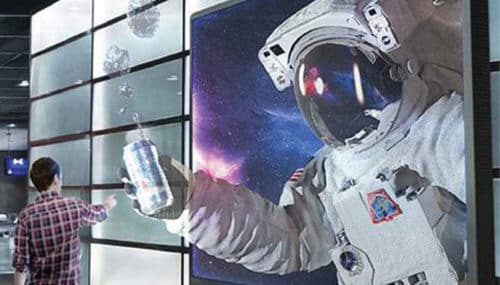Holographic displays use light refraction to create 3D images that can be viewed without special glasses. This makes them highly desirable for applications ranging from medicine to augmented reality.
Digital device development never stands still, and the next big thing in devices could be the integration of 3D holography. This area is attracting considerable interest from tech developers and researchers. Technical advances in control of electronic displays have taken the ease of operation to a whole new level and allowed safe, fast and easy updates.

Holographic displays
A holographic display uses coherent light, such as that created by laser, to create a three-dimensional (3D) image in space. The hologram seems to be based on principles seen in photography and, in essence, is a 3D photograph.
Photographs aim to capture an image through light that has passed through a lens and onto a sensor. Modern digital cameras typically contain a sensor known as charge-coupled device (CCD) or complementary metal-oxide semiconductor (CMOS), which translates the captured light into a digital image.
Holograms differ from photographs in the image capture method. These aim to capture additional image data by using a laser and splitting the beam to illuminate the subject from two different angles. The light reflected off the subject is captured on a holographic plate, which is similar to an undeveloped strip of film. When light strikes an object with an irregular surface, it bounces off at a huge variety of angles, so different aspects of the object are disclosed when it’s viewed from different perspectives.
In a hologram, a beam of light passes through a so-called diffraction fringe, which bends the light so that it, too, emerges at a host of different angles. One way to produce holographic video is to create diffraction fringes from patterns displayed on an otherwise transparent screen. The problem with that approach is that the pixels of the diffraction pattern have to be as small as the wavelength of the light they’re bending, and most display technologies don’t happily shrink down that much. In another approach, holographic-video displays are created by adopting acousto-optic modulation, in which precisely engineered sound waves are sent through a piece of transparent material. The waves basically squeeze and stretch the material, changing its index of refraction.
Holographic technology projects 3D light images, and these projections may be used to display 3D images. The science of creating holograms is known as holography, and the secret behind this futuristic technology is light. The man who discovered the principles supporting holography was physicist and Nobel Prize (1971) winner Dennis Gabor. Dennis Gabor conducted several holography experiments that he called wave-front reconstruction. Early days of holographic technology may have been limited as Gabor resorted to using electrons to create imagery. However, modern holography seems to benefit from the use of lasers, which may have propelled Gabor’s underlying approach into a new era of innovation.
The early prototypes of tele-immersive displays require users to wear special goggles and ¬a head device that tracks the viewpoints of users looking at the screen. On the other end, the people that appear as 3D images are tracked with an array of seven ordinary video cameras, while two other video cameras capture real light patterns projected in each room to calculate distances. This enables the proper depth to be re-created on the screen. So, if a viewer moves his head to the right, he can see the corresponding images that would be seen if he were actually in the room with the person on the screen.
Images on the screen are split and polarised to create a different image for each eye. The goggles then combine these images so that the brain recognises only one 3D image. If that rate could be improved to 10 frames per second, it would create a seamless projected image that would be like looking through a window at another person. Scientists are developing new technologies (including the Internet, display technologies, haptic sensors and desktop supercomputers) to support this type of communication.

Electronics with holography
Since its inception in the 1940s, holography seems to be gradually making its way toward integration with everyday devices and may potentially become a part of our daily lives. The potential applications of 3D digital holograms are enormous. In addition to arts and entertainment, various fields including biomedical imaging, scientific visualisation, engineering design and displays could benefit from this technology. For example, creating full-sized organs for 3D analysis by doctors could be helpful, but it remains a challenge owing to the limitation of hologram-generation techniques.
Researchers are looking to create flexible and elastic thin films that could be used on a whole range of surfaces, opening up the horizons of holographic applications. This achievement in holographic technology may grant electronic devices with advanced optical images and potentially many other uses.
Tele-immersion will blur the lines between real and computer-generated images. It will be the ultimate tele-commuting technology, almost entirely eliminating the rush-hour drive to work. Instead of commuting, people could attend board meetings by projecting themselves into the company’s conference room.
Holography promises to change how we approach technology. From medical diagnostics to education, data storage, defence and cyber security, 3D holography has the potential to transform a range of industries. There is anticipated interest from consumers who may wish to watch their favourite movies from their smartphones, projected off screen in 3D. Several tech companies are evaluating smartphones and wearables in preparation for integration of holographic sensors.
Some current applications
- Holographic interferometry is used by researchers and industry designers to test and design many things, from tyres and engines to prosthetic limbs and artificial bones and joints.
- Supermarket and department store scanners use a holographic lens system that directs laser light onto the bar codes of the merchandise.
- Holographic optical elements are used for navigation by airplane pilots. A holographic image of the cockpit instruments appears to float in front of the windshield. This allows the pilot to keep his eyes on the runway or the sky while reading the instruments. This feature is available on some models of automobiles.
- Medical doctors can use three-dimensional holographic CAT scans to make measurements without invasive surgery. This technique is also used in medical education.
- Holograms are used in advertisements and consumer packaging of products to attract potential buyers.
- Holograms have been used on covers of magazine publications, as well as sports trading cards.
- Use of holograms on credit cards and debit cards provides added security to minimise counterfeiting.
- Holography has been used to make archival recordings of valuable and/or fragile museum artifacts.
- Sony Electronics uses holographic technology in their digital cameras. A holographic crystal allows the camera to detect the edge of the subject and differentiate between it and the background. As a result, the camera is able to focus accurately in dark conditions.
- Holography has been used by artists to create pulsed holographic portraits as well as other works of art.
- Future colour LCDs will be brighter and whiter as a result of holographic technology.
- Holographic night-vision goggles
- Many researchers believe that holographic televisions will become available within a decade. Holographic motion pictures have been previously attempted and may become a reality within the next few years.
- Holographic memory is a new optical storage method that can store one terabyte (1000GB) of data in a crystal approximately the size of a sugar cube. In comparison, CDs can hold 650-700MB, DVDs 4.7GB, and computer hard drives 120GB.
- Optical computers will be capable of delivering trillions of bits of information faster than the latest computers.
Challenges and solutions
Holograms don’t move. To make them move, we need to create a hologram in real time. This needs little tiny pixels—smaller than anything we can build in large volume at low cost. Although the holographic displays research community has made significant advances in recent years, the prospect of a true holographic display still remains elusive. Holographic displays are still at the basic research stage and require significant technological advances before they become commercially feasible.
People expect that high-quality holograms will entertain them in the near future, because visualisations are increasingly becoming sophisticated and highly imaginative due to the use of computer-aided graphics and recently-developed digital devices that provide augmented or virtual reality. To be commercially feasible in a range of applications—from medicine to gaming to media—the hologram challenge is daunting. It involves scaling an electronic device to a size small enough to fit on a table top, while making it robust enough to render immense amounts of data needed to create a full-surround 3D viewing experience from every angle—without the need for special glasses or other viewing aids.
The capacity of holographic-video displays is measured according to the space-bandwidth (SB) product. The SB product is the product of the number of pixels and their spatial frequency—the inverse of their size. So we are looking for a large number of very small pixels. To have a large number of pixels is not really helpful if these are large.
One of the big barriers to the consumer application of holographic technology has been the price of the components. Affordable holographic displays could easily be valuable to the gaming and entertainment industries, and could add a new dimension to videoconferencing.
Some of the limitations and their possible solutions for electronics holographic displays are summarised below.

Image quality
Digital holograms are often associated with noisy, low-contrast, low-resolution and mono-colour imagery. High-contrast, high-resolution and full-colour digital holograms can be formed using existing hardware devices, yielding images that more closely match the quality of conventional displays.
Computation speed
Due to the complexity of required calculations, digital holograms are also often associated with slow, off-line calculations. However, eye-tracked approximate holograms provide correct image focus and best image quality.
Focus control
The ability to change the image focus is desirable in a near-eye display: It addresses the accommodation-convergence conflict, allows image focus to match eye focus in a see-through display, and adds realism. Unlike vari-focal, multi-focal and light field displays, a holographic display is able to provide per-pixel focus control with virtually no discretisation, enabling smooth and natural focal cues to imagery.
Vision correction
Another desirable quality of a display is vision correction—the ability to fix defects in the user’s vision. Such a display allows users to view the display without their glasses. Recent holographic displays can correct simple vision problems such as near- and far-sightedness as well as higher-order vision problems like astigmatism.
Aberration correction
Holographic displays are also capable of aberration correction—encoding optical corrections to the display optics in software. Such a capability allows use of simpler optics and enables new optical architectures. The optical correction capability of holograms allows arbitrary optical corrections on a per-pixel basis.
Form factor
One of the most important considerations for a near-eye display is form factor, especially for see-through, mixed-reality devices. Lightweight, eyeglasses-like displays are needed to facilitate viewer comfort and all-day use.
Technological developments
In the past, researchers interested in holographic display systems proposed or focused on methods for overcoming limitations in the combined spatial resolution and speed of commercially available, spatial light modulators. Representative techniques included space-division multiplexing, time-division multiplexing and combination of these two techniques.
Implementing a viewing window design demands close attention to the optical image system. Holography is being advanced through development of structure materials at the nanoscale. These allow devices to achieve new optical properties that go beyond the properties of natural materials.
With a tabletop display, a viewing window can be created by using a magnified virtual hologram, but the plane of the image is tilted with respect to the rotational axis and projected using two parabolic mirrors. As parabolic mirrors do not have an optically-flat surface, visual distortion can result.
This problem can be solved by designing an aspheric lens, which allows multiple viewers to observe 8cm (3.2-inch) holograms from any position around the table without visual distortion. Building on these advances, researchers hope to implement a key design feature of strategically sizing the viewing window, so that it is closely related to the effective pixel size of the rotating image of the virtual hologram. Watching through this window, observers’ eyes are positioned to accept the holographic image light field because the system tilts the virtual hologram plane relative to the rotational axis.
To enhance the viewing experience, the team hopes to design a system in which observers can see 8cm holographic 3D images floating on the surface of the parabolic mirror system at a rate of 20 frames per second. Test results of the system using a 3D model and computer-generated holograms were promising—though right now still in a monochrome green colour. Next, the team wants to produce a full-colour experience and resolve issues like undesirable aberration and brightness mismatch among the four digital micromirror devices used in the display.
In an attempt to assimilate holographic technology with modern electrical devices, a team of researchers has created the world’s thinnest hologram. The team claims the thickness of holograms has typically been limited to the optical wavelength scale, something which seems to have reduced integration with thin electronic devices. However, researchers were able to surpass this limit and achieve holograms 60nm in size using a topological insulator material—a material which seems to behave as an insulator while also having conducting states upon its surface.
An advantage of this new nano-hologram is the way users may observe holographic projections outside of 3D glasses requirements. This means consumers may potentially witness nano-holograms built into electronic devices such as smartphones, computers or TVs in the future as they require additional peripherals necessary for operation. With this breakthrough in technology, the research team claims the next step for the technology is the development of a new method to adapt holography for LCD screens.
A graduate student at MIT (USA) Media Lab has developed an inexpensive optical chip that, when combined with a prototype display, “renders colour holographic video at resolutions equal to that of a standard-definition TV. Besides the low cost of the chip, the true advance is the way the colours are handled. In the past, red, green and blue light had to be handled separately, resulting in lower image resolution. This chip handles these lights simultaneously, allowing for both higher resolutions and more efficient processing.”
The new approach to generating holograms could lead to colour holographic-video displays that are much cheaper to manufacture than today’s experimental (2D), monochromatic displays. The same technique could also increase the resolution of conventional 2D displays. Thus, in the original Star Wars’ movie, the inviting but grainy special effects hologram might soon be a true full-colour, full-size holographic image due to advances by a research team refining 3D holographic displays. The team described a novel tabletop display system that allows multiple viewers to simultaneously view a hologram showing a full 3D image as they walk around the tabletop, giving complete 360-degree access.
A South Korean research team has developed a 3D holographic display that performs more than 2600 times better than existing 3D holographic displays. It is expected to improve the limited size and viewing angle of 3D images, which were a major problem of the current holographic displays.
To create a 3D hologram that can be viewed without special equipment such as 3D glasses, the wavefront of light must be controlled using wavefront modulators such as spatial light modulators and deformable mirrors. A wavefront modulator is an optical manipulation device that can control the direction of light propagation. However, the biggest limitation to using these modulators as 3D displays is the number of pixels.
The large numbers of pixels that are packed into high-resolution displays developed in recent years are suitable for a 2D image, and the amount of information contained in those pixels cannot produce a 3D image. For this reason, a 3D image that can be made with existing wavefront modulator technology is 1cm in size with a narrow viewing angle of 3 degrees, which is far from practicable.
Dr S.S. Verma is a professor at Department of Physics, Sant Longowal Institute of Engineering and Technology, Sangrur, Punjab







